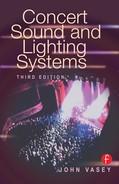CHAPTER 10
INSERTS
Units inserted in the audio chain to modify or control the signal are called inserts. Most consoles have insert points for each channel, subgroup master, auxiliary outputs, and main outputs. Inserts can be equalizers if more equalization is required than available on the console; noise gates for reducing spill from other instruments or residual noise from direct sources; or limiters for controlling the level or producing compression effects. The two most common inserts are limiters and noise gates (Figure 10–1).
LIMITERS 
Limiters fix a ceiling of maximum level without changing the dynamic range below the threshold. The amount of gain reduction depends on the ratio control setting, which can vary from no compression to infinite compression at the threshold. The level at which compression begins is set by the threshold control. An output level control can adjust the overall gain. Compression is the process of reducing dynamic range; a compressed signal has a higher average level.
To smooth out variations in microphone level, use a low compression (2:1). To smooth out variations in instrument level, use a 4:1 ratio. Smooth a bass sound by lessening the variations between the strings and increasing the sustain. To raise a signal out of a mix, apply compression and raise the level. The compressed signal will have a reduced dynamic range and a higher average level. To protect the speakers, the limiter ratio should be infinite and the threshold set at the input voltage of the amplifier.

Figure 10–1. Insert rack. The two most common units inserted are limiters-compressors and noise gates.
NOISE GATES 
Noise gates are used to control the point at which a channel is on when the gate is open to keep residual unwanted background noise from being amplified. The channel remains off until a certain input level is achieved. The amount of signal gated is a function of both ratio and threshold. The attenuation limit sets the desired amount of noise suppression. Attack and release control the speed of attenuation. Attack applies to the signal heard as it comes out of the noise gating mode. Release governs the time for the signal to die away once the gate is shut. Noise gates can be operated by means of an external source that switches the gate on when an external signal is applied through the key connector. Some gates switch on once a signal has reached a certain level and then remain on, even if the signal falls below the threshold.
A quick setup procedure for noise gates is as follows. Set ratio and attenuation limit to the maximum. Set attack and release controls to the fastest positions. Listen to the signal. Set the threshold for the desired cutoff point. Adjust the ratio to achieve the desired rate of signal decay. Use the attack and release controls to set the smoothness of attenuation. Finally, set the attenuation limit control for the desired amount of noise to be suppressed.
